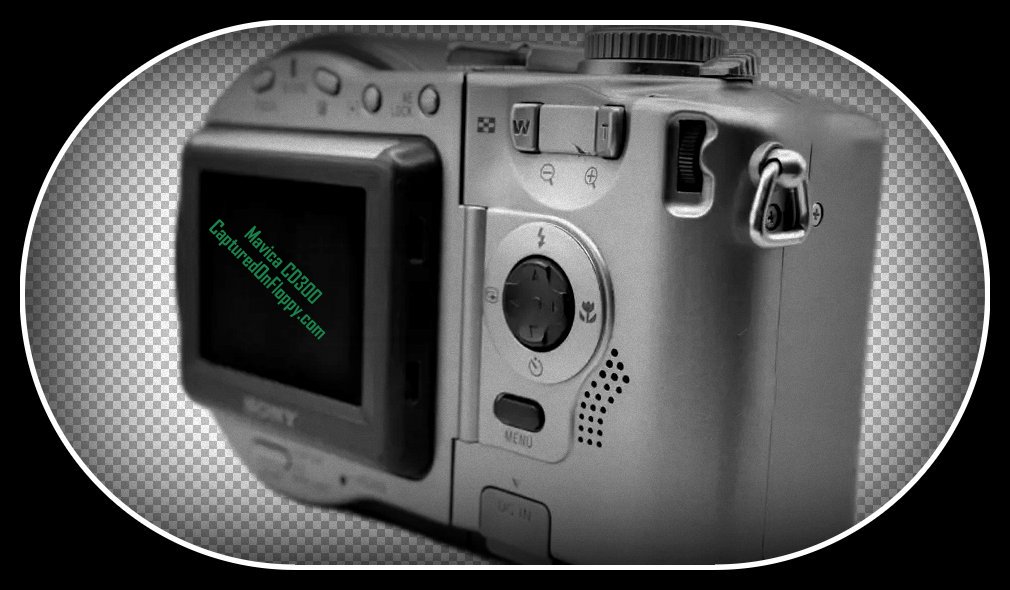
Sony Mavica MVC-CD300

About the CD300:
The Sony Mavica CD300 is a late-era hybrid Mavica combining 3.5" floppy
support with Memory Stick capability and CD-based workflows. It focused
on higher image quality and practical archival options, offering a 2MP
(or marketed 3.3 MP variant in some regions) CCD and hybrid storage
options for flexibility.

[Captured On Floppy]

[Captured On Floppy]
Historical Context
- Release Date: 2002
- Lineage: One of the final hybrid (floppy + Memory Stick) Mavica cameras, following FD200 and FD300 in the late floppy era.
- Market Position: Targeted home users, educators and small businesses who wanted archivable media and simple PC transfer options.
Key Features & Specifications
| Image Sensor | 2.0 MP, 1/2.7" CCD |
|---|---|
| Resolution | 1600 × 1200 pixels (JPEG) |
| Lens | 3x optical zoom, 6.3–19mm f/2.8–2.9 (41–123mm equiv.) |
| Digital Zoom | 2x (up to 6x total) |
| Macro | Focus as close as ~8cm |
| Storage | 3.5" 1.44MB floppy disk & Memory Stick slot |
| Image Format | JPEG (Fine/Standard), BMP |
| Movie Mode | MPEG (Memory Stick only) |
| LCD | 2.5" TFT color |
| Battery | Sony NP-FM50 InfoLithium (Li-Ion) |
| Connectivity | USB, A/V out, DC in |
| Dimensions | Approx. 126 × 86 × 75 mm |
| Weight | Approx. 410 g (without battery/floppy) |
| Software | Sony PictureGear for Windows |
| Release Price | ~$350 USD |
Detailed Features
Sensor & Image Quality
2MP (marketed in some places as 3.3MP); JPEG compression with Fine/Standard options and BMP support — suitable for prints up to 8×10 and decent web/documentation use.
Lens & Zoom
3x optical zoom (41–123mm equiv.) with macro mode for close-up work.
Storage & Transfer
Hybrid storage: floppy for universal compatibility and Memory Stick for higher capacity and faster write speeds; Memory Stick enables MPEG movie capture.
Display & Controls
2.5" LCD for shooting/review and a simple menu system for exposure, white balance, and playback.
Battery & Power
InfoLithium batteries provide reliable power; AC adapter available for long sessions.
Other
Pop-up flash with red-eye reduction, self-timer, exposure compensation, and USB file transfer.
User Experience
- Image Quality: Decent for its era; good for documentation and web use.
- Storage Flexibility: Hybrid design let users choose universal floppy archiving or Memory Stick for more shots and video.
- Speed: Floppy write times are slow; Memory Stick is much faster and more convenient.
- Portability: Compact and lightweight for a Mavica-era camera.
- Reliability: With careful handling, both floppies and Memory Sticks performed reliably.
Legacy & Impact
- Hybrid Bridge: Helped late adopters transition from floppy to solid-state storage.
- End of an Era: One of the last Sony floppy-capable Mavicas.
- Collector Value: Sought after for its hybrid nature and as a late-stage Mavica collectible.
Comparison to Other Mavica Models
- FD200: Successor with similar body/features and improved MPEG video.
- FD95/FD97: Higher resolution variants with larger zoom ranges.
- FD92: Earlier hybrid with different zoom/resolution balance.
- Older FD series: Lower resolution, floppy-only models with better floppy shot counts.
Manual & My Opinion
Download the official manual (PDF)
My Opinion:
I first handled a CD300 at a local camera
meet in 2003 — seeing a camera that could write to a floppy and also
support Memory Sticks and CD workflows felt like watching the last
chapter of an experimental era. The hybrid approach gave users real
choice: floppy discs for quick, widely-compatible archiving, and Memory
Sticks when capacity and speed mattered. For its day the CD300 struck a
unique and solid balance between practicality and innovation; it’s a
charming reminder of how manufacturers navigated the transition toward
fully solid-state photography.
I have not owned oner but have the CD500 . These cameras I can only
base my thoughts on research of the camera.
 |
